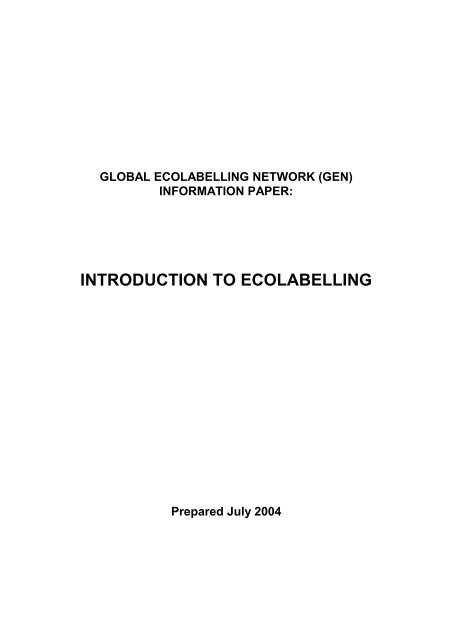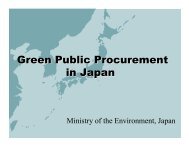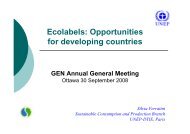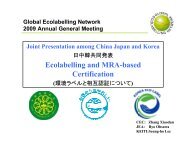Introduction to Ecolabelling (July 2004) - Global Ecolabelling Network
Introduction to Ecolabelling (July 2004) - Global Ecolabelling Network
Introduction to Ecolabelling (July 2004) - Global Ecolabelling Network
Create successful ePaper yourself
Turn your PDF publications into a flip-book with our unique Google optimized e-Paper software.
<strong>Introduction</strong> <strong>to</strong> <strong>Ecolabelling</strong>This document provides an introduction <strong>to</strong> ecolabelling 1 -- general objectives, guiding principles,key features, and some indica<strong>to</strong>rs of success.What is "<strong>Ecolabelling</strong>"?Basically, an ecolabel is a label which identifies overall environmental preference of a product (i.e.good or service) within a product category based on life cycle considerations. In contrast <strong>to</strong> a selfstyledenvironmental symbol or claim statement developed by a manufacturer or service provider, anecolabel is awarded by an impartial third party <strong>to</strong> products that meet established environmentalleadership criteria.<strong>Ecolabelling</strong> is only one type of environmental [performance] labelling, and refers specifically <strong>to</strong>the provision of information <strong>to</strong> consumers about the relative environmental quality of a product.There are many different environmental performance labels and declarations being used orcontemplated around the world. Figure 1 (in Appendix A) provides a schematic representation ofthe various types of labels that currently exist.As has been identified by the International Organization for Standardization (ISO), the overall goal ofthese labels and declarations is:"...through communication of verifiable and accurate information, that is notmisleading, on environmental aspects of products and services, <strong>to</strong> encouragethe demand for and supply of those products and services that cause lessstress on the environment, thereby stimulating the potential for market-drivencontinuous environmental improvement".The ISO has undertaken efforts <strong>to</strong> attempt <strong>to</strong> standardise the principles, practices and keycharacteristics relating <strong>to</strong> three major voluntary environmental labelling types -- Type I -environmental labelling (i.e. ecolabels), Type II - self-declaration claims and Type III - environmentaldeclarations (e.g. report cards/information labels). Box 1 provides general definitions of thesedifferent types.Unlike Type III environmental declarations, ecolabels reflect a determination and recognition of aproducts' environmental performance leadership characteristics rather than simply a presentation ofquantified environmental data. In this respect, the ecolabels "flag" leadership products in themarketplace rather than requiring consumers <strong>to</strong> undertake their own comparative analyses. Box 2highlights some further contrasting aspects of the three types of labels and declarations.1 This paper discusses and uses the term -- ecolabelling -- as applied by <strong>Global</strong> <strong>Ecolabelling</strong> <strong>Network</strong> (GEN) officials. It isacknowledged that the term has assumed a much broader application and possible understanding in the public domain.
Box 2: Comparison of the Three Types of Labels and DeclarationsCriteria Areas / Metrics:Life Cycle Consideration:Type IType IIType IIImultiplesinglemultipleType IType IIType IIIyesnoyesSelectivity:Third Party Verification/Certification:Type IType IIType IIIyesnonoType IType IIType IIIyespreferredyesAround the world, there are many other third-party labelling systems in place, or being developed,which are "hybrids" of ecolabelling because they have narrower focuses than a normal ecolabellingprogram. These alternative programs focus on a single sec<strong>to</strong>r (e.g. the forestry industry, the chemicalindustry, etc.), and/or address only one environmental issue (e.g. air quality, energy conservation,etc.), and/or consider only a single life cycle phase in their applications (e.g. product use, productdisposal/recycling, etc.). Of further note, some other "Type I" programs have been designed andimplemented <strong>to</strong> address and recognise more than simply environmental performance aspects.In a typical ecolabelling program, product categories and ecolabelling criteria are determined by anindependent organisation with assistance from a complementary technical advisory group. Generally,once a category is chosen, some form of life cycle review is conducted. This review may include rawmaterial extraction, manufacture, distribution, use and disposal. The differentiating parameters (e.g.energy use, <strong>to</strong>xicity, etc.) are then used as the basis for criteria development.Companies which want <strong>to</strong> participate in an ecolabelling program make application and submit theirproducts for third party compliance testing and/or verification. If approved, the companies paylicensing fees for permission <strong>to</strong> use the program's distinctive ecolabel symbol for a specified period.Use of the ecolabel is restricted <strong>to</strong> the approved product(s), and is usually moni<strong>to</strong>red by the managingagency.
- 4 -<strong>Ecolabelling</strong> Objectives<strong>Ecolabelling</strong> has become a useful <strong>to</strong>ol for governments in encouraging sound environmentalpractices, and for businesses in identifying and establishing markets (i.e. domestic and sometimesinternational) for their environmentally preferable products. Many countries now have some form ofecolabelling in place, while others are considering program development. Commitment <strong>to</strong> clearobjectives has been critical <strong>to</strong> the success of ecolabelling programs around the world. While programofficials may express them differently, three core objectives 3 are generally established and pursued:1. Protecting the environmentEnvironmental conservation and protection is generally a primary objective. Through ecolabellingprograms, governments and/or non-governmental program authorities seek <strong>to</strong> influence consumerdecisions and encourage the production and consumption of environmentally preferable goods andthe provision and use of environmentally preferable services. In this regard, ecolabelling serves as amarket-based instrument intended <strong>to</strong> bring about environmental improvement. Specific environmentalobjectives may include:• encouraging the efficient management of renewable resources <strong>to</strong> ensure their availability <strong>to</strong>future generations;• promoting the efficient use of non-renewable resources, including fossil fuels;• facilitating the reduction, reuse and recycling of industrial, commercial and consumer waste;• encouraging the protection of ecosystems and species diversity; and• encouraging the proper management of chemicals in products.2. Encouraging environmentally sound innovation and leadership<strong>Ecolabelling</strong> programs, through the awarding and promotion of an ecolabel, offer a market incentive <strong>to</strong>environmentally innovative and progressive businesses. By offering products that reduce stress on theenvironment, the businesses can establish or reinforce a market niche and positive corporate imageamong consumers, thereby realising an advantage (and possibly compelling other businesses <strong>to</strong>follow suit). Generally, ecolabelling criteria are set <strong>to</strong> reward only the <strong>to</strong>p environmental performers ina product category. Most programs gradually and incrementally raise standards <strong>to</strong> encourageproducers and service providers <strong>to</strong> keep pace with new and emerging performance improvemen<strong>to</strong>pportunities and market shifts.3. Building consumer awareness of environmental issues<strong>Ecolabelling</strong> programs can also serve <strong>to</strong> heighten consumer awareness of environmental issues andof the implications of their choices. In countries where there is a high degree of consumer awareness,a trusted ecolabel that provides reliable information on the environmental impacts of products in themarketplace may be all that is required <strong>to</strong> promote the selection of ecolabelled products. In countrieswhere consumers are not as highly motivated by environmental concerns, ecolabelling can be used <strong>to</strong>promote environmentally beneficial actions.- 5 -3 While not exactly an "objective", some program planners and authorities have identified and are exploring the merits ofusing ecolabelling as a "trade-positive" <strong>to</strong>ol (i.e. for promoting export products in foreign markets where consumerawareness and concern for environmental impacts is established and significant).
Guiding Principles for <strong>Ecolabelling</strong>Based on the experiences of successful ecolabelling programs and pertinent ISO work, a series ofprinciples can be identified as being critical <strong>to</strong> an effective and credible program:1. Voluntary participationThe decisions of manufacturers, importers, service providers and other businesses <strong>to</strong> participate in anecolabelling program must be voluntary. Programs should also be designed and operated so thatpotential industry participants (and other interested parties) can request that ecolabelling categoriesand criteria be developed for their products.2. Compliance <strong>to</strong> environmental and other relevant legislationA key contribu<strong>to</strong>r <strong>to</strong> the credibility of an ecolabelling program is the nature and extent of programparticipation requirements, both product-specific and more general conditions. While the main focusof the ecolabelling criteria relates <strong>to</strong> the environmental aspects and performance of a product beingoffered, it is important <strong>to</strong> also address the regula<strong>to</strong>ry compliance of a producer's/provider's facility fromwhich the product is being offered. It is generally accepted that a basic component of industry[environmental] leadership is full compliance with relevant environmental and other legislativerequirements. (This compliance requirement may be a licensing condition for program participationrather than a product compliance criterion.) The approach usually taken is <strong>to</strong> require compliance <strong>to</strong>legislation applicable on a local/regional scale. This approach acknowledges, and avoids challenging,the varying regula<strong>to</strong>ry requirements that may exist in different jurisdictions. It also avoids imposing onforeign program applicants what could be perceived as "unnecessary obstacles <strong>to</strong> trade".3. Consideration of "fitness for purpose" and level of overall performanceBesides legislative compliance, it is also important <strong>to</strong> address the quality and performance of aproduct that is <strong>to</strong> be considered for ecolabelling. The credibility of both the ecolabel and theecolabelling program could suffer if products bearing the ecolabel don't demonstrate comparablequality and reasonable performance in relation <strong>to</strong> alternatives. Market and consumer surveys andresearch have shown that environmental attributes is only one fac<strong>to</strong>r considered by consumers in theirpurchasing decisions, and is usually only fac<strong>to</strong>red in once comparable quality and performance hasbeen established.4. Based on sound scientific and engineering principlesMaintenance of stringent technical requirements based on good ecological science assuresconsumers that they can trust the ecolabel and licensing applicants that they will be treated fairly.Further, there is a strongly prevailing view that product environmental criteria should be based onindica<strong>to</strong>rs arising from life cycle considerations. The rationale is that there is a generally perceived[growing] need <strong>to</strong> assure consumers, as well as producers and service providers, that all aspects of aproduct's development, provision, use and end-of-life options have been taken in<strong>to</strong> account.- 6 -
criteria levels keep pace with new developments. Many programs allow for standards <strong>to</strong> be upgradedat any time, while granting licensees a specified period of time <strong>to</strong> meet the revised standards.10. Consistency with ISO 14020 and ISO 14024 guiding principles (or otherappropriate documents)As the acceptance and adoption of the ISO 14000 series of standards by industry and governmentscontinues <strong>to</strong> increase around the world, it may prove advantageous for ecolabelling programs <strong>to</strong>demonstrate consistency with the guiding principles contained in the relevant ISO environmentallabelling standards (refer <strong>to</strong> Boxes 3 and 4). Such consistency could provide greater perceivedlegitimacy and soundness for ecolabelling programs in place and under development. Nevertheless,<strong>Global</strong> <strong>Ecolabelling</strong> <strong>Network</strong> (GEN) officials have initiated efforts <strong>to</strong> devise and implement a "GENGuiding Principles" document pertinent <strong>to</strong> the development, management and operation ofecolabelling programs/schemes.Box 3: ISO 14020 -- Guiding Principles for Environmental Labelling(including Type I - <strong>Ecolabelling</strong>)accuracyavoiding unnecessary trade barriersscientific basisprovision of information on methodologylife-cycle approachallowance of innovationminimal administrative burdenopen, consensual processprovision of information on products
- 9 -Major ParticipantsMultiple stakeholder participation in any ecolabelling initiative is important <strong>to</strong> its overall impact andsuccess. While no two programs are identical, most involve the participation of the following groups [alsorefer <strong>to</strong> Figure 1 below]:GovernmentMany programs are initiated and funded by government departments or agencies. Besides providinginput (directly and/or indirectly) in program development, management and delivery areas, government atdifferent levels can exert significant influence and demand through its procurement initiatives andactivities.Program management authority (i.e. Program Managers)An independent body typically oversees and directs the program delivery activities (e.g. technical,marketing, and administrative aspects). The level of involvement in delivery may range from co-ordinatingfunctions and liaison among different delivery agencies <strong>to</strong> performing the actual day-<strong>to</strong>-day operationaltasks.Industry and commercial associations, retailers and companiesIndustry and commercial sec<strong>to</strong>r awareness, interest and direct involvement are essential <strong>to</strong> programsuccess. Formulated criteria for certification and licensing must be credible and practical in the marketplace. Industry and retail involvement is key in this regard. Industry and commercial sec<strong>to</strong>r guidance andsupport from the outset and in all program facets is desirable. It should be recognized that industryrepresents product producers and service providers, as well as procurers.ConsumersConsumer demand -- whether in households, institutions or corporations -- generates market impact.Consumer requirements and preferences must be determined, recognized and reflected in variousprogram initiatives and outputs.
- 10 -Figure 1: <strong>Ecolabelling</strong> Participants*Program ManagersIndustry Associations,Retailers, Producers andService Providerse.g. Academic Experts, Media,NGO's, Consumer Groups* "Government" is not identified in this Figure, since "Government" may serve different roles underdifferent programs, or may assume different roles at various stages in the evolution of an ecolabellingprogram.
- 11 -Interested partiesThe credibility of a program can be enhanced through the involvement and support of variousorganizations, groups and individuals with no direct commercial interest in ecolabelling. Conversely,omission of such groups can jeopardize public confidence and acceptance.- AcademiaIncorporating leading-edge research and expertise in<strong>to</strong> the criteria development andreview processes can improve the quality, cost effectiveness and efficiency of outputs.- MediaImportant group for promoting ecolabelling <strong>to</strong> consumers and industry.- International CommunityThis broad category may include foreign consumers, industry representatives andparticipants, and other potential non-domestic interested parties (i.e. academic experts,media, NGO's, etc.). With the globalization of markets has arisen an increasingrequirement for ecolabelling programs <strong>to</strong> expand their consultative efforts beyonddomestic borders.
- 12 -Overview of Key StepsAssuming program management officials have acquired a general knowledge and understanding ofenvironmental priorities <strong>to</strong> be considered and addressed through their ecolabelling program, programdelivery generally involves three basic steps:1. Selection and determination of product categories;2. Development and adoption of appropriate criteria, standards or guidelines(including: development, public review, and finalisation/announcement); and3. Certification and licensing(including: application, testing and verification, and license issuing).1. Selection and determination of product categoriesThe selection of categories is a critical part of the ecolabelling process, since it has a major impact on theeligibility of specific products. The extent of the category can also determine the stringency of the criteriafor certification. For example, in the case of batteries, a different approach will be taken if all batteries areconsidered rather than only rechargeable ones. As far as possible, the determining fac<strong>to</strong>r is normallyinclusion of all products that routinely perform the same function.Proposals for certification criteria categories are generally accepted from any source. In practice, mostproposals arise from industry, or internally from the program managers. Trade, consumer, environmentaland other public organisations can also request consideration of specific categories. After formal review,often with technical advisory groups, selections are made. Most programs also have some guidingprinciples <strong>to</strong> assist in selection. These often include the environmental impact of the product, the degreeof differentiation between products within the proposed category, and the importance of the product in themarketplace.2. Development and adoption of appropriate criteria, standards or guidelinesOnce product categories are selected, the requirements that an applicant must meet <strong>to</strong> be approved bythe ecolabelling program must be established. Technical and scientific specialists, generally from bothgovernment and the private sec<strong>to</strong>r, prepare draft criteria that are then made available <strong>to</strong> interested partiesfor consideration and feedback. Comments are received and reviewed by program staff, technical expertsor an advisory group, and are reflected when appropriate in the final criteria.The complexity and limitations of full life-cycle assessment methodologies have led <strong>to</strong> the use of relativelysimpler and less comprehensive methods of environmental performance review. After consideration ofthe life cycle of a product, programs usually focus on a few key attributes -- such as recycled content,reduced <strong>to</strong>xicity, pollution reduction, energy efficiency and capacity for recycling -- and assess the rangeof industry performance in these chosen areas.- 13 -
No matter the method of analysis, selection of certification criteria is a difficult task. Each program usinglife-cycle review is doing it in a different way. Given that none are conducting a comprehensive life-cycleassessment, each is open <strong>to</strong> challenges that its criteria selection is based on a limited number ofattributes. Added <strong>to</strong> this concern is the need <strong>to</strong> compare and give value <strong>to</strong> different kinds of impacts.Studies of ecolabelling strategies and practices have raised several important questions related <strong>to</strong> theseconcerns. If, for example, a new production method significantly reduces the load of water pollution, butat the same time increases the use of fossil fuels and air pollution emissions, is the new method <strong>to</strong> beregarded as environmentally more sound than the old one? How can one compare the impacts tha<strong>to</strong>ccur <strong>to</strong>day with those that are expected in the future? Is the standard economic method of discountingfuture costs and gains appropriate with regard <strong>to</strong> environmental issues?In spite of these difficulties, there is a trend <strong>to</strong> move <strong>to</strong>wards more comprehensive life-cycle reviews andcloser co-operation among programs <strong>to</strong> try <strong>to</strong> harmonise criteria where possible. Also, program officials insome countries have elected <strong>to</strong> generally focus on a limited number of key environmental criteria.In a few specific instances, particular program officials have implemented and applied "load point" ratingmethods. Under such systems, points are awarded according <strong>to</strong> the level of compliance with certainestablished criteria rather than requiring that the applicant meet all requirements. Applicants achieving acertain score then become eligible for certification. Although this type of system raises concernsregarding <strong>to</strong>o much flexibility on environmental protection issues, it does give potential applicants greaterscope in developing methods <strong>to</strong> reduce environmental stress.3. Certification and licensingWhen certification criteria are established, applicants (e.g. manufacturers, suppliers, distribu<strong>to</strong>rs,importers or service providers who decide <strong>to</strong> participate in a program through having their productsdetermined <strong>to</strong> be in compliance with the criteria) may apply for certification under the program. Thisprocess involves compliance verification and testing, applicant licensing and moni<strong>to</strong>ring.Applicants are usually required <strong>to</strong> submit technical information (e.g. test reports, evidence of compliancewith the law/regulations, evidence of a quality management system, etc.) with their application. In addition,the implementation body may direct and/or perform an on-site audit or inspection. In some cases,independent verification is carried out by the program, and in others, a declaration by the applicant isaccepted on the assumption that competi<strong>to</strong>rs or environmental groups will notify program officials if thereis a suspicion that inaccurate information has been provided. Applicants generally pay an application feeand the costs of verification.Once the applicant is licensed <strong>to</strong> use the label on, or in association with its certified product(s) or service,an annual fee is charged for use of the ecolabel.Certification requirements and costs must be carefully and thoughtfully devised in order not <strong>to</strong>discriminate against some segments of industry, notably small- and medium-size enterprises that canencounter program participation difficulties.- 14 -Measuring Success
How effective is ecolabelling in achieving its objectives? How can "success" be measured? With amajority of national ecolabelling programs having only been established in the last decade, efforts <strong>to</strong>measure effectiveness are incomplete. Nonetheless, positive responses of industries and consumerssuggest that ecolabels are perceived as useful marketing <strong>to</strong>ols and generally accepted symbols ofenvironmentally sound consumer choices.Given the difficulty in separating out the impact of ecolabelling from other economic, environmental andsocial policies, few programs have tried <strong>to</strong> claim direct environmental benefits from ecolabelling.Nevertheless, efforts so far <strong>to</strong> measure the effectiveness of ecolabelling programs have generallyfocused on such indica<strong>to</strong>rs as the improvement in environmental quality of certified products, industryparticipation, and consumer recognition.Improvement in environmental quality of certified productsOver time, the success of an ecolabelling program is partly demonstrated through higher environmentalstandards for products. Most ecolabelling practitioners support the need <strong>to</strong> and implement routine reviewand revision processes <strong>to</strong> address technological and market advances, especially for product categoriesin which certified products and licensees exist.Industry participationAn ecolabelling program is a voluntary policy instrument, using the marketplace rather than regulation <strong>to</strong>achieve environmental goals. It therefore has <strong>to</strong> offer something <strong>to</strong> businesses <strong>to</strong> encourage them <strong>to</strong>participate. Producers and service providers must be confident that being part of the program will improvetheir situation in the marketplace and/or enhance their corporate image. Credibility aspects are important<strong>to</strong> them as is a fee structure that is reasonable, fairly assessed, and does not discriminate againstcompanies based on size, location or other general fac<strong>to</strong>rs.In measuring industry participation, most ecolabelling programs can report a substantial and continuousincrease in both criteria categories and certified products against the criteria. The growth in categoriesalone, however, may not be indicative of industry interest, as some categories may not have many (oreven any) corresponding licensees.On the other hand, an increase in certified products indicates that producers and/or service providers seeadvantage in displaying the ecolabel. Consumer surveys testify <strong>to</strong> a consistent preference for productsthat are perceived as environmentally positive. While consumer focus may shift from one criterion <strong>to</strong>another (e.g. from packaging, <strong>to</strong> elimination of <strong>to</strong>xic substances, <strong>to</strong> preservation of wildlife), thewillingness of a large proportion of consumers <strong>to</strong> choose "green" products and pay a premium for themhas been regularly confirmed. (Nevertheless, surveys have also shown that superior environmentalperformance generally only becomes a key competitive fac<strong>to</strong>r once product performance, quality andvalue have been established.)- 15 -An expanding number of licensees is another success indica<strong>to</strong>r. Other success indica<strong>to</strong>rs relating <strong>to</strong>industry participation are the levels of voluntary "drop-outs" and determined instances of non-compliance.The more successful a program, the greater the potential costs associated with leaving or being de-
licensed.Another indica<strong>to</strong>r, which some programs have begun <strong>to</strong> encounter, is the revoking of a certificationcriteria standard due <strong>to</strong> overall industry improvement making the initially developed environmentalleadership criteria no longer appropriate (or necessary).One other success indica<strong>to</strong>r area is overall industry involvement in criteria category selection, criteriadevelopment and review, and marketing activities incorporating an ecolabel.Consumer recognition and demandConsumer recognition and demand is critical <strong>to</strong> the success of an ecolabelling program. Withoutevidence that the program promotes its activities and licensees, and consumers recognise and trust theecolabel, it is difficult <strong>to</strong> enlist and maintain industry participation.It takes several years <strong>to</strong> build consumer and industry confidence. A key task is <strong>to</strong> ensure that informationabout the ecolabel and the certified products effectively reaches consumers. Tracking consumerrecognition, therefore, has been an important feature of many programs. Surveys indicate that recognitionalso implies trust and the possibility that consumers will be motivated <strong>to</strong> make purchasing decisionsbased on their shared belief that the product chosen will cause less environmental damage than itsalternatives.The involvement of and support by environmental NGO's (i.e. non-government organisations), consumerorganisations and the media are key fac<strong>to</strong>rs which have contributed <strong>to</strong> increasing the level of consumerawareness of environmentally preferable products in certain countries.In countries where consumer awareness of environmental issues is low, it may be difficult <strong>to</strong> convincecompanies that there is any advantage <strong>to</strong> be gained from an ecolabel. This suggests that some initialeducation work may be necessary prior <strong>to</strong>, or in conjunction with, the introduction of ecolabelling. Even incountries with a high degree of environmental awareness, initiatives have been undertaken <strong>to</strong> promotethe ecolabel and the products that display it.Beyond ecolabel recognition, consumer demand -- in the form of household, institutional and corporatepurchases 4 of ecolabelled products -- is a key success indica<strong>to</strong>r. Greater impacts are also realised whenecolabelling criteria are used as "guidance <strong>to</strong>ols" <strong>to</strong> identify greener products for governmentprocurement and institutional purchasing. While opinion poll results can be helpful in assessing demand,purchasing patterns records are a more accurate means.4 Internationally, emphasis is increasingly shifting from end-consumer <strong>to</strong> procurement purchasing in government, industry andinstitutions as part of corporate responsibility.
- 16 -For more information on ecolabelling and the <strong>Global</strong> <strong>Ecolabelling</strong> <strong>Network</strong> (GEN), please contact GENofficials and/or visit the GEN Web site. The contact information is as follows:Mr. Evan BozowskyManagerGLOBAL ECOLABELLING NETWORK (GEN) SECRETARIATTERRACHOICE ENVIRONMENTAL SERVICES INC.1280 OLD INNES ROAD, SUITE #801, OTTAWA, ONTARIO, CANADA K1B 5M7PHONE: +1 613 247-1900FAX: +1 613 247-2228.E-MAIL: gensecretariat@terrachoice.comMs Hiroko MizunoGLOBAL ECOLABELLING NETWORK (GEN) GENERAL AFFAIRS OFFICEJAPAN ENVIROMENT ASSOCIATION (JEA).PRIME KAMIYACHO BUILDING 2F, 1-11-9 AZABUDAI, MINATO-KU,TOKYO 106-0041 JAPANPHONE: +81 3 5114-1255FAX: +81 3 5114-1257.E-MAIL: dc3h-mzn@asahi-net.or.jpWORLD WIDE WEB HOME PAGE ADRESS:http//www.gen.gr.jp







